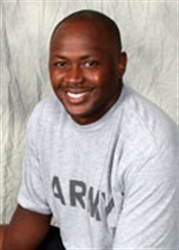 by A Soldiers Mind
by A Soldiers Mind
Since the wars in Afghanistan and Iraq began, more amputees than from any other war, have opted to continue their career in the military and proven that their amputation didn’t prevent them from performing their duties and doing so very well. Take Captain David Rozelle, who lost his foot in Iraq to a roadside bomb. He remained in the Army, went back to Iraq leading a combat team and has competed in many marathon and triathlon competitions. Or, US Navy Petty Officer Casey Tibbs, who lost his leg in a motorcycle accident, remains in the Navy today and competes in the Paralympics in running events.
Or perhaps you remember the story awhile back about Army 1LT Juan Castro who was blinded in Iraq and has ran the Army 10 Miler. All Soldiers that we’ve featured here at A Soldier’s Mind and all of these men have overcome their injuries and continued to serve our nation. A few years ago, this would have been a very rare occurrence. Today however, with the advances in prosthetics, many have been able to return to active duty and remain in the Army. I don’t have exact numbers, but know that about a year ago, the number was in the 60s. They have to basically prove that they can still pass the military physical standards.
Yet another Hero has overcome injuries he received in Iraq, and in doing so, has become the first ever amputee to be accepted into Warrant Office School. This spring, he’ll join his fellow students at the school and from what I’ve read about SSG Johnathan Holsey, he’ll be a darn fine Warrant Officer. He’s to report to the school in Fort Rucker, Alabama in April. Currently he is assigned to the Human Resources Command in Alexandria, Virginia.2
Hosley was injured in November 2004 when a roadside bomb detonated. At the time he was assigned to the 1st Battalion of the 503rd Infantry Regiment. The bomb caused severe damage to his left leg. His leg wasn’t amputated right away. About two weeks after he arrived at Walter Reed Army Medical Center, he was fighting a severe infection in his leg, when doctors told him that they would need to amputate, due to that infection.
“I remember the day when the doctor came in,” he recalled. “I remember the doctor coming in on the 22nd of November and … he told me that it was best that we amputate, but it was my choice.”3
Imagine having to make a decision like that after two weeks, post injury. I’m sure that there was a lot of hope that the doctors would be able to save his leg, so I can just imagine how devastating and difficult it was to have to make that decision. Through the support of his family and his faith, SSG Holsey made the decision to follow the doctors advise and go ahead with the amputation.
“Family is very important to the recovery process,” he added.4
Holsey persevered and decided that he wanted to continue to serve in the Army. Throughout his recovery, he thought hard about he could continue to meet the challenges that come with being an amputee. Almost 5 months after his injury, he was fitted for his first prosthetic leg. He learned how to manage the challenge of not having a leg, by participating in some of the activities that Walter Reed has for patients, such as skiing and fishing.
“I’m blessed in my recovery, and I try to challenge myself to figure it out,” he said. “Even though you might have lost your leg, it doesn’t mean you can’t do … things. You just have to figure out how to balance it or figure out how to do it. You have all these questions … things you probably never thought of,” he added. “Before I became an amputee, I can honestly say I never met one and probably never knew one.”5
Holsey has always been a person who meets challenges put in his way, head on. He knew he wanted to continue to serve his country and never let anything stop him. In March 2006, shortly after he completed his rehabilitation, he attended Basic Noncommissioned Officer Course (BNCOC). He was on his way to becoming the first amputee ever to be accepted to Warrant Officer School.
“It was an interesting thing for me, because I was one of the first human resources soldiers to go as a amputee,” Holsey said. “I felt that even though I wanted to stay – I wanted to be a Soldier regardless – this is what we do. I wanted to go the next rank and knew this was something I had to do.”6
For Holsey, BNCOC was interesting. The instructors questioned whether he could complete the annual physical fitness test. That didn’t stop him and he sought guidance on how he could perform and complete his annual test. Just like those amputees before him, who blazed the trail and showed that an amputee could perform their duties as Soldier, Holsey is blazing new trails of his own. Hopefully his example as a Soldier and a leader will inspire other young Soldiers who might face similar hurdles in their path, to never give up and continue to reach for their dreams.
ATTENTION READERS
We See The World From All Sides and Want YOU To Be Fully InformedIn fact, intentional disinformation is a disgraceful scourge in media today. So to assuage any possible errant incorrect information posted herein, we strongly encourage you to seek corroboration from other non-VT sources before forming an educated opinion.
About VT - Policies & Disclosures - Comment Policy



